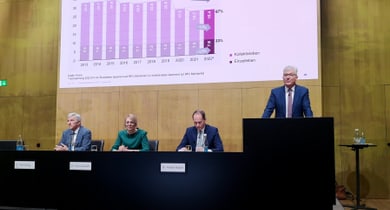
Insurers defy economic uncertainties in 2022
Private insurers in most branches recorded a moderate increase in premium volumes in 2022, according to the SIA’s projections, once again demonstrating stability in an economically challenging year. The non-life segment in particular demonstrated above-average growth at 3 per cent. Premium volumes in the life segment remained more or less stable. In addition, a new study by BAK Economics attests to the economic significance of reinsurers to Switzerland.
Swiss private insurers have fared relatively well in a year marred by economic uncertainty. Although insurers were not spared the effects of inflation and capital market turbulence, they maintained a strong performance with solid solvency and robust premium volumes, which increased slightly in 2022. ‘Once again the private insurance sector has demonstrated stability in a difficult environment,’ said Rolf Dörig, president of the Swiss Insurance Association SIA, speaking at the annual media conference in Zurich. He stressed that this is not least thanks to the framework conditions in Switzerland, which have to be continually safeguarded. ‘This is the only way that insurers can continue to strengthen the resilience of the Swiss economy and its population, and thus perform its economic responsibility,’ he added, alluding to the important reform of the occupational pension system. From the perspective of the SIA, all elements for a good solution are available. ‘It's now up to parliament to finish the work started as soon as possible,’ stressed Dörig.
Growth in all branches of non-life business
Non-life business continued it trajectory of the past few years and recorded 3 per cent growth on the previous year, according to the SIA’s projections. ‘This saw it exceed a long-standing growth average. It's also a sign of the robust demand of the previous year,’ comments Urs Arbter, the association's director. This was particularly marked in the fire, natural hazard and property damage insurance segment, which grew by 8.3 per cent, attributable primarily to higher insured values. In motor vehicle insurance, premium volumes remained largely constant, although the sector insured a higher priced and larger vehicle portfolio. However, rising premiums are expected in the near term, reflecting long-term cost increases.
- +0.3 per cent in motor vehicle insurance. Increased customer demand for comprehensive motor vehicle insurance policies is offset by a drop in premiums for motor vehicle liability insurance.
- +8.3 per cent in fire, natural hazard and property damage insurance. The primary drivers of this sharp increase are a growing building stock and rising insured amounts.
- +3.4 per cent in professional and general liability insurance. Higher claims quotes are anticipated due to the revised Insurance Contract Act, leading in turn to higher premiums. In addition, part of the growing cyber insurance market falls into the category of general liability insurance.
- +2.1 per cent in accident insurance. Non-occupational accidents have risen over the past few years, leading to adjustment of premiums in line with risk.
- +2.3 per cent in daily sickness benefit insurance. Alongside continuous wage growth, higher benefit payments are leading to an increase in premiums.
Life business more or less stable, OPA reform remains urgent
After a sharp decline in premium volumes in some areas of life insurance business from 2020, growth in unit-linked insurance products in the individual life segment in 2022 ensured an overall premium volume almost at the previous year's level. However, group business continues to decline. The good news for life insurers is the normalisation of interest rates, which promises long-term earnings prospects in the important bond business. ‘However, higher guarantees cannot be issued until the increase in interest rates is proven sustainable,’ cautions Ruedi Kubat, SIA board member and CEO of Allianz Suisse. He stresses that even if the solvency of life insurers proves that they have met these challenges with the right strategies, a reform of the second pillar remains inevitable and urgent.
- -1.9 per cent in group life insurance. Falling periodic premiums are an indication of a continuation of the trend towards partial autonomy.
- +2.5 per cent in individual life insurance. Single premiums in particular are seeing significant growth in comparison with previous years. But the level is still significantly lower than before 2015.
New study confirms major economic significance of reinsurers
The BAK Economics-led study 'Volkswirtschaftliche Bedeutung der Rückversicherung in der Schweiz’ was also presented at the annual media conference. The study confirms that globally active reinsurers are one of the most productive sectors of the Swiss economy. With a value added of CHF 3.7 million per full-time position, they exceed the production level of the overall economy many times over. Reinsurers have recorded sharp growth since the turn of the millennium, boosting their significance within the insurance sector considerably. With claims payments of almost CHF 22 billion in 2021, Swiss-based reinsurers contribute significantly to the stability and thus the resilience of the global economy. With 45 reinsurers, most of which are based in the Zurich/Zug region, Switzerland is the world's third-largest reinsurance location. ‘Our country benefits from reinsur-ers in various respects, whether as risk carriers, capital providers, taxpayers or in the form of expertise and highly specialised personnel,’ says Nina Arquint, president of the SIA's Reinsurance Committee and Chief Risk Officer of Swiss Re Corporate Solutions. This makes it all the more important that Switzerland remains an attractive location. For internationally active reinsurers, access to open reinsurance markets worldwide and inter-nationally compatible regulation and oversight adapted to the business model are particularly important in their choice of location.
No projections are available for reinsurance business in 2022. The SIA expects the growth trend to continue with a slight increase in premium volume.
Note to editors
The Swiss Insurance Association (SIA) represents the interests of the private insurance industry at national and international level. The association has approximately 70 members, which include many specialist, national-level property, life and supplementary health insurers, and global primary insurers and reinsurers. Private insurers employ about 50,000 people in Switzerland. The sector is among the most productive and highest value-adding of the economy. With their expertise in risk coverage and hazard prevention, private insurers assume economic responsibility: they make a significant contribution to the stability of Switzerland's economic system and prosperity. With that in mind, the SIA is committed to the sustainable development of the sector and its locations.
Media contact
Swiss Insurance Association SIA
Lisa Schaller, media spokesperson
Phone: +41 44 208 28 56
Email: lisa.schaller@svv.ch
Head office phone: +41 44 208 28 28
Presentations and Presidential Address in German
- Rolf Dörig: Unser Land braucht eine BVG-Reform, die ihren Namen verdient
- Urs Arbter: Entwicklung des Prämienvolumens in der Schweizer Versicherungswirtschaft 2022
- Nina Arquint: Rückversicherungen als Eckpfeiler des Versicherungsstandorts Schweiz
- Ruedi Kubat: Auswirkungen von Zinsen und Inflation auf die Versicherungswirtschaft
- Bild der SVV-Jahresmedienkonferenz 2023
You may also be interested
- Context | 1 August 2025
Members
The member companies of the SIA account for more than 85 percent of the premiums generated in the Swiss market.

- Study | 31 January 2023
BAK study shows the economic significance of reinsurers in Switzerland
For Switzerland as a business location, reinsurers are important risk carriers, capital providers and taxpayers that make a significant contribution to service exports.

- Industry news | 8 February 2023
Sicherheit bieten, um Widerstandsfähigkeit zu stärken
Das Jahr 2022 aus Sicht der Privatversicherer im Videorückblick.
